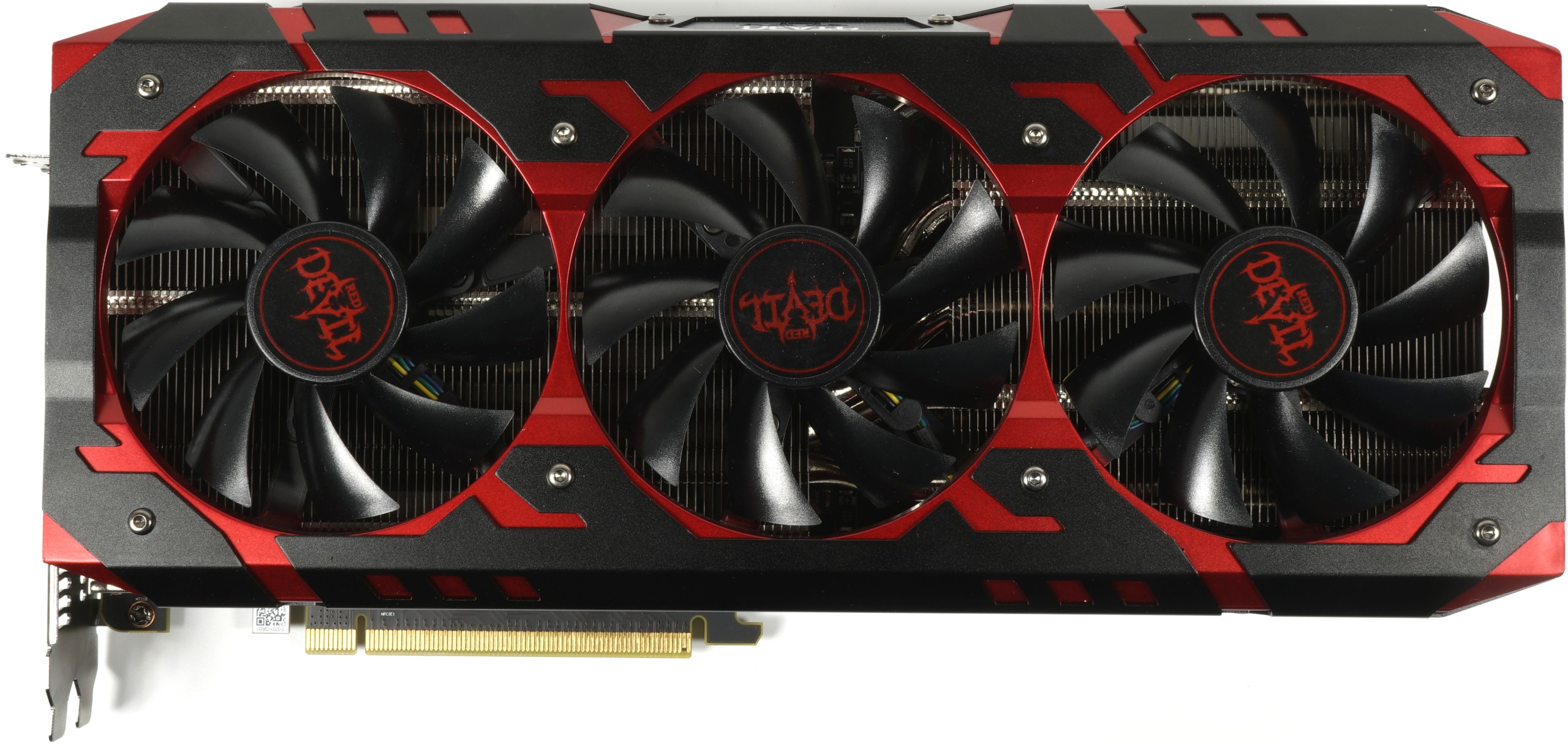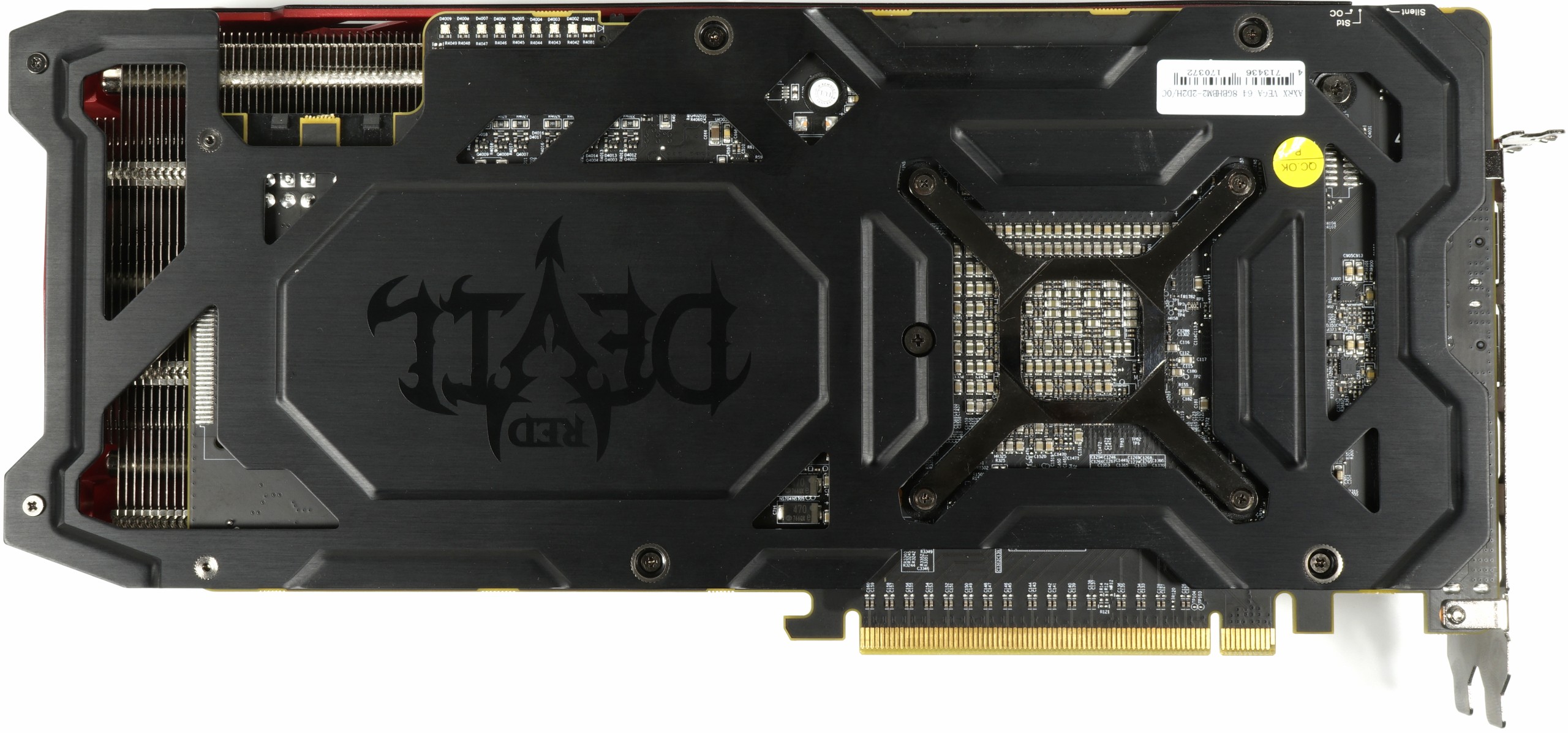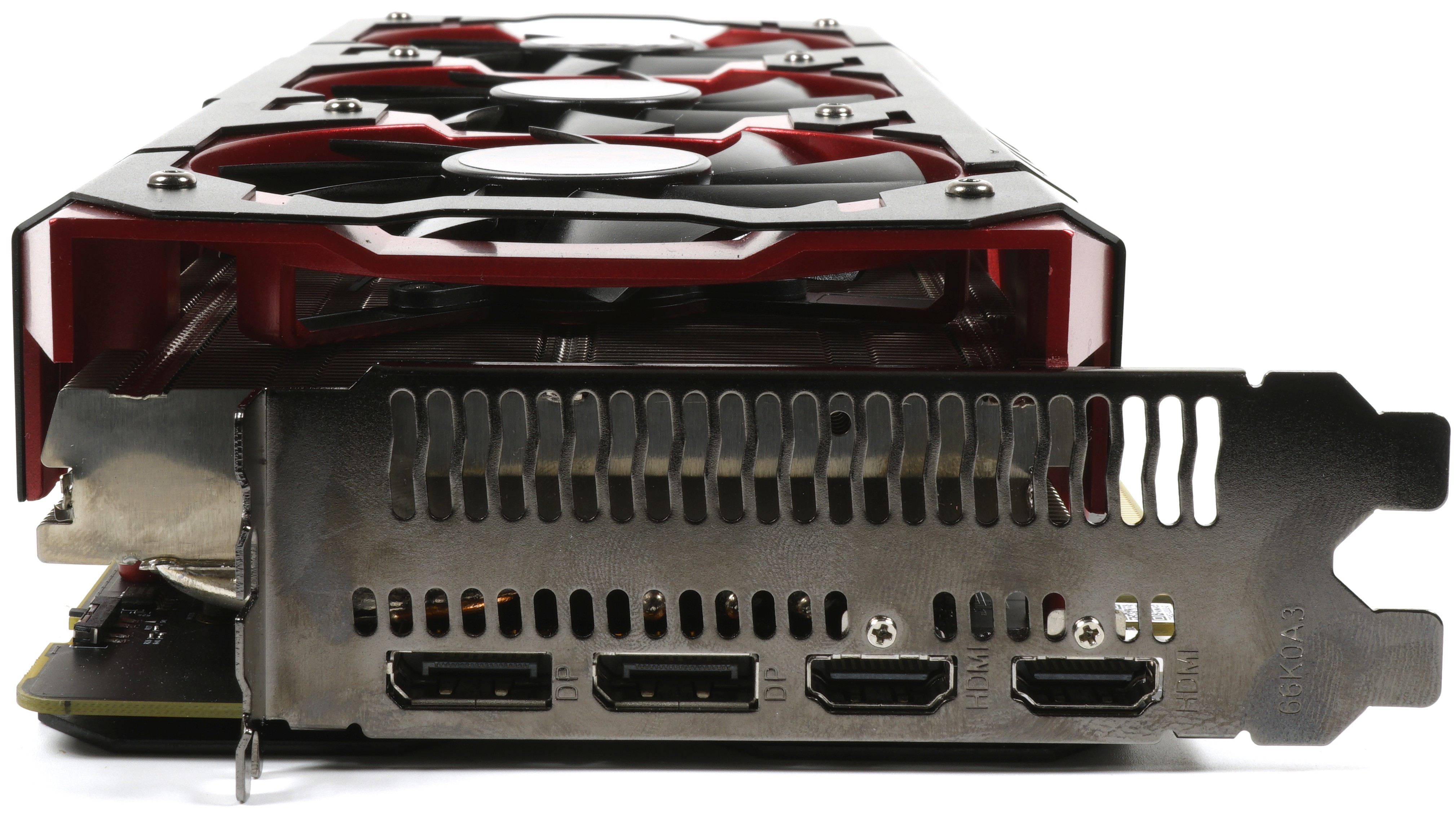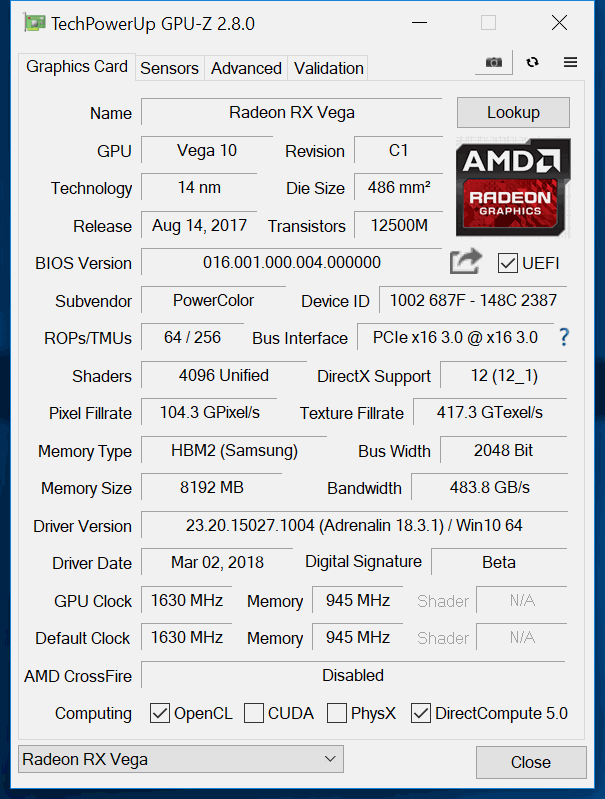Tom's Hardware Verdict
Up against the other Radeon RX Vega 64 cards, PowerColor's solution stands strong with a powerful cooler and better-than-reference performance. However, it's still priced unreasonably high, particularly compared to GeForce GTX 1080 boards selling for hundreds of dollars less.
Pros
- +
Capable cooling solution
- +
Faster than AMD's reference card
- +
Powerful visuals
Cons
- -
Price
- -
Higher noise output than competing cards
- -
Three-slot width
- -
No evidence of a claimed semi-passive fan mode
Why you can trust Tom's Hardware
Features & Specifications
If you asked us to point you in the direction of a well-equipped Radeon RX Vega 64 card, and if there was more differentiation between the boards that do exist today, we could definitely recommend checking out PowerColor's Red Devil RX Vega 64 8GB HBM2. Like Sapphire's Radeon RX Vega 64 Nitro+, the PowerColor card is particularly eye-catching. And it lights up, if you're a proponent of drawing attention to flagship-class graphics hardware in a windowed case.
Unfortunately, today's market makes it almost impossible to distinguish between one Radeon RX Vega 64 or another. You may find a handful of models in stock (an improvement compared to a few weeks ago), but they still start just under $800 and reach as high as $900. While PowerColor does land toward the bottom of that range, you're still paying a $200+ premium over many GeForce GTX 1080 models. Right out of the gate, PowerColor is fighting an uphill battle against less expensive and sometimes faster competition.
Unboxing, Look, & Feel
Weighing in at 1409 grams, this card lands just below Sapphire's monstrous flagship, which proved to be a an exhibition of sorts and is no longer available. PowerColor's solution is real though, and it's a massive beast just like Asus' ROG Strix Radeon RX Vega 64 8GB OC Edition. Similar to that card, the Red Devil measures 30.2cm long. A height of 12.7cm from the motherboard slot's top edge to the top of the fan shroud also matches what you get from Asus. But a depth of 5.2cm is notably wider. Hopefully that translates to even better cooling performance.
Three 90mm fans are mounted in 92mm openings. With their special shape, a total of nine blades per fan provide powerful throughput and less turbulence, generating a bit more static pressure. This should prove complementary to the deep thermal solution.
The backplate is characterized by a printed Red Devil logo. That plate doesn't help with cooling at all; it's primarily meant to look good and give the heavy card some rigidity.
Plan for an extra 5mm of clearance (at least) behind the Red Devil RX Vega 64. This may cause problems on some motherboards, particularly if the heat sink/backplate intrude on an occupied expansion slot or large CPU cooler.
As we can see from the bottom, PowerColor employs vertically-oriented fins. At the expense of occupying a third slot with its 2.5-slot design, the company does provide a lot more surface area for cooling.
Get Tom's Hardware's best news and in-depth reviews, straight to your inbox.
The top side shows that PowerColor stays true to itself in the Red Devil's design. In addition to a familiar dark metal cover on the red ABS shell, there is an illuminated Red Devil logo in the middle. A pair of eight-pin power connectors are position at the end of the board. They're rotated 180 degrees and recessed as well.
Apart from three 6mm heat pipes and a single 8mm pipe, the almost completely closed back of the card reveals nothing conspicuous.
The rear bracket plays host to four display outputs. A pair of HDMI 2.0 interfaces is ideal for anyone with a VR HMD, while two DisplayPort 1.4 connectors make multi-monitor configurations easy. DVI is noticeably missing.
Unfortunately, we also have to bring up an issue that affected our test results. While our press sample was sealed by the manufacturer, it became clear that this card had been used and dismantled before landing in our lab. The amount of thermal paste we found on the GPU package would have been sufficient for two or more cards, and was nearly counterproductive the way it arrived. We fixed this by cleaning the card and applying much better stuff in moderation.
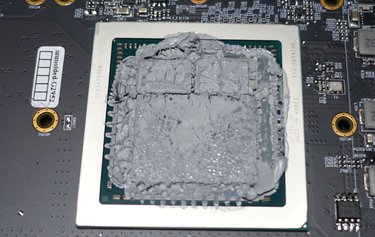
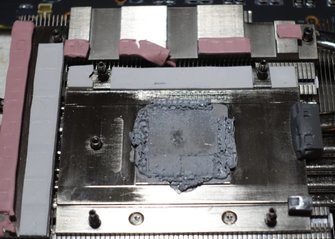
We realigned the heat pads, and even repaired the partially destroyed ones with similar replacements. In turn, we were rewarded with a four to five degree lower GPU temperature and significantly cooler VRM readings. Hopefully, that gets us close to PowerColor's stock performance, fresh from the factory.
Although PowerColor's official documentation claims a 1607 MHz boost clock, GPU-Z reports 1630 MHz. That specification is mostly wishful thinking though, given the Red Devil's power limit.
In comparison to the relevant reference cards the data looks as follows:
| Model | Radeon RX Vega 64 | PowerColor Red Devil RX Vega 64 | Radeon RX Vega 56 | GeForce GTX 1070 Ti | GeForce GTX 1080 |
|---|---|---|---|---|---|
| GPU | Vega 10 | Vega 10 | Vega 10 | GP104 | GP104 |
| Die Size | 486 mm² | 486 mm² | 486 mm² | 314 mm² | 314 mm² |
| Transistors | 12.5 billion | 12.5 billion | 12.5 billion | 7.2 billion | 7.2 billion |
| Base/Boost Clock Rate | 1274/1546 MHz | 1274/1630 MHz | 1156/1471 MHz | 1607/1683 MHz | 1607/1733 MHz |
| Shaders/SIMDs | 4096/64 | 4096/64 | 3584/56 | 2432/19 | 2560/20 |
| Texture Units/ROPS | 256/64 | 256/64 | 224/64 | 152/64 | 160/64 |
| Pixel Fill Rate | 99 GPix/s | 104 GPix/s | 94 GPix/s | 108 GPix/s | 114 GPix/s |
| Texture Fill Rate | 396 GT/s | 417 GT/s | 330 GT/s | 244 GT/s | 257.1 GT/s |
| Memory Interface | 2048-bit | 2048-bit | 2048-bit | 256-bit | 256-bit |
| Memory Type | HBM2 | HBM2 | HBM2 | GDDR5 | GDDR5X |
| Memory Bandwidth | 484 GB/s | 484 GB/s | 410 GB/s | 256 GB/s | 320 GB/s |
| Memory Speed | 1.89 Gb/s | 1.89 Gb/s | 1.6 Gb/s | 8 Gb/s | 10 Gb/s |
| Memory Size | 8GB | 8GB | 8GB | 8GB | 8GB |
| DX12 Feature Level | 12_1 | 12_1 | 12_1 | 12_1 | 12_1 |
| PCIe Power Connectors | 2x 8-Pin | 2x 8-Pin | 2x 8-Pin | 1x 8-Pin | 1x 8-Pin |
| TDP | 295W | 295W | 210W | 180W | 180W |
Test System & Measurement Methods
We introduced our new test system and methodology in How We Test Graphics Cards. If you'd like more detail about our general approach, check that piece out. We've upgraded the CPU and the cooling system since then to make sure that nothing's holding back graphics cards as fast as this one.
The hardware used in our lab includes:
| Test System | |
|---|---|
| Hardware | Intel Core i7-6900K @ 4.3 GHzMSI X99S XPower Gaming TitaniumCorsair Vengeance DDR4-32001x 1TB Toshiba OCZ RD400 (M.2, System SSD)2x 960GB Toshiba OCZ TR150 (Storage, Images)be quiet Dark Power Pro 11, 850W PSUWindows 10 Pro (All Updates) |
| Cooling | Alphacool Eisblock XPX5x be quiet! Silent Wings 3 PWM (Closed Case Simulation)Thermal Grizzly Kryonaut (Used when Switching Coolers) |
| Case | Lian Li PC-T70 with Extension Kit and ModsConfigurations: Open Benchtable, Closed Case |
| Monitor | Eizo EV3237-BK |
| Power Consumption Measurement | Contact-free DC Measurement at PCIe Slot (Using a Riser Card)Contact-free DC Measurement at External Auxiliary Power Supply CableDirect Voltage Measurement at Power Supply2 x Rohde & Schwarz HMO 3054, 500 MHz Digital Multi-Channel Oscilloscope with Storage Function4 x Rohde & Schwarz HZO50 Current Probe (1mA - 30A, 100 kHz, DC)4 x Rohde & Schwarz HZ355 (10:1 Probes, 500 MHz) 1 x Rohde & Schwarz HMC 8012 Digital Multimeter with Storage Function |
| Thermal Measurement | 1 x Optris PI640 80 Hz Infrared Camera + PI Connect Real-Time Infrared Monitoring and Recording |
| Noise Measurement | NTI Audio M2211 (with Calibration File, Low Cut at 50Hz) Steinberg UR12 (with Phantom Power for Microphones) Creative X7, Smaart v.7 Custom-Made Proprietary Measurement Chamber, 3.5 x 1.8 x 2.2m (L x D x H) Perpendicular to Center of Noise Source(s), Measurement Distance of 50cm Noise Level in dB(A) (Slow), Real-time Frequency Analyzer (RTA) Graphical Frequency Spectrum of Noise |
Specifications
| GPU (Code-name) | Vega 10 |
| Shader Units | 4096 |
| Base & Boost Clocks | 1630 MHz |
| Memory Size & Type | 8GB HBM2 |
| Memory Clock | 1.89 Gb/s |
| Memory Bandwidth | 484 GB/s |
| Fans | (3) 90mm |
| Ports | (2) HDMI 2.0, (2) DisplayPort 1.4 |
| Power Connectors | (2) 8-pin PCIe |
| Dimensions (LxHxD) | 30.2 x 12.7 x 5.2cm |
| Weight | 1409g |
| Warranty | 2 Years |
MORE: Best Graphics Cards
MORE: Desktop GPU Performance Hierarchy Table
MORE: All Graphics Content

Igor Wallossek wrote a wide variety of hardware articles for Tom's Hardware, with a strong focus on technical analysis and in-depth reviews. His contributions have spanned a broad spectrum of PC components, including GPUs, CPUs, workstations, and PC builds. His insightful articles provide readers with detailed knowledge to make informed decisions in the ever-evolving tech landscape
-
Gillerer I wouldn't trust PowerColor's quality control.Reply
My old HD 5850 came with an "Engineering Sample" BIOS with no officially supported way of updating it. -
10tacle Nice to still see some AMD high end GPU reviews on Tom's. Well done. Unfortunately, this review continues to prove that AMD is well behind Nvidia in the upper tier GPU segment when it comes to gaming bang for the buck. AMD just doesn't have the R&D pockets that Nvidia does because they have shifted focus to CPU/APU production. I would love to see an AMD competitor to Nvidia's GTX x80 Ti high end GPU. Their last stab at it was with the Fury X against the 980 Ti which fell as flat as Bulldozer.Reply -
davidgirgis "We have a hard time recommending..." -Igor WallossekReply
However...
"9/10" and "Editor's Choice"
"Been dazed and confused for so long it's not true" -Robert Plant -
redgarl Reply21026800 said:Nice to still see some AMD high end GPU reviews on Tom's. Well done. Unfortunately, this review continues to prove that AMD is well behind Nvidia in the upper tier GPU segment when it comes to gaming bang for the buck. AMD just doesn't have the R&D pockets that Nvidia does because they have shifted focus to CPU/APU production. I would love to see an AMD competitor to Nvidia's GTX x80 Ti high end GPU. Their last stab at it was with the Fury X against the 980 Ti which fell as flat as Bulldozer.
It is the use of HBM 2 and the shortage that skyrocket the price of this card. The Vega 64, unfortunately, is a mining card. With proper undervolting and tweaks, it performs really well, unfortunately, for gaming at this price you better getting a TI. Still, if the price was about the same as a 1080, I would grab a Vega instead. -
eric.m.hudson1 "I wouldn't trust PowerColor's quality control.Reply
My old HD 5850 came with an "Engineering Sample" BIOS with no officially supported way of updating it."
That's a long time to hold a grudge. I've had 2 PowerColor 290x's and Red Devil RX 480 and 580 cards. All of them were great performers and had better cooling than the majority of the competition. Also, they were all unlocked/dual bios cards. I like what PowerColor does with AMD cards. -
Rogue Leader Card sounds great, looks awesome, but the price is double what its worth (and I say that as someone who owns a Liquid cooled Vega 64).Reply -
Rogue Leader Reply21027991 said:https://i.imgur.com/BfZBaTL.jpg
Was $1100 US this morning, now a more reasonable $719. Still here in the US a GTX 1080 can be had for $120 cheaper minimum and performs basically the same. However at the price where you are its totally reasonable. -
TJ Hooker Reply
You should really include the context for that first quote:21026820 said:"We have a hard time recommending..." -Igor Wallossek
However...
"9/10" and "Editor's Choice"
"But even though it's generally faster than GeForce GTX 1080, Nvidia's closest competitor is currently available at a $200+ savings. We have a hard time recommending any Radeon RX Vega 64 with such a chasm between boards best suited to 2560x1440 gaming."
A GTX 1080 and Vega 64 have the same MSRP, but he's saying the fact that the Vega is selling for $200 more makes it hard to recommend. Although in reality the price difference is much lower in many places.
Edit:
The price delta between the cheapest 1080 and Vega 64 on PCpartpicker US is $30 right now ($70 for red devil specifically). On Newegg.com that expands to $50 and $90, but only because that includes a dinky single fan 1080 that's $20 cheaper.21028036 said:Was $1100 US this morning, now a more reasonable $719. Still here in the US a GTX 1080 can be had for $120 cheaper minimum and performs basically the same. However at the price where you are its totally reasonable. -
hurnii Re: "Semi-passive" cooling mode not working:Reply
My Red Devil's BIOS switch has 3 positions:
Max OC (fairly useless)
Middle Position ("Normal ?")
Semi-Passive Mode
When switching BIOS, the Computer needs to be turned off, the switch set to the desired position, then Computer PSU turned back on.
For my card, if I turn the computer Off, set the BIOS switch position to semi-passive, and then turn the computer on, the fan stays off (passive mode) while the OS boots up.
In fact, when I first installed the card, the switch was already in semi-passive mode, so when the computer booted up initially, no fans spun. Had to shutdown, flip the switch, and power back up. That time, the fans did spin.

